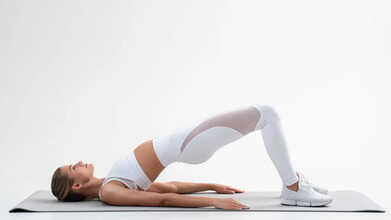- Health Conditions A-Z
- Health & Wellness
- Nutrition
- Fitness
- Health News
- Ayurveda
- Videos
- Medicine A-Z
- Parenting
- Web Stories
This One Proven Strategy Can Help You Lose Fat And Gain Muscle Simultaneously

Image Credit: Canva
As we enter the new year, most of us are making big fitness goals in terms of changing our bodies, which is either to lose weight or gain muscle. These two are often seen as conflicting goals, but there is a very effective strategy that allows you to achieve both at the same time: body recomposition. This process involves changing your body's fat-to-muscle ratio by losing fat and building lean muscle. Though it may seem complex, with the right approach, body recomposition can yield sustainable results and a transformative physique.
Body recomposition is not like traditional weight loss and muscle gain approaches. While typical weight loss plans focus solely on reducing body fat, and muscle-building programs push for a caloric surplus to gain muscle, body recomposition requires a more intricate balance. It's about reducing body fat while simultaneously building muscle. It's not about shedding weight rapidly or gaining significant muscle mass within a short period.
Rather, it's about slow, progressive changes to your body composition over time. It calls for careful planning and dedication along with the right balance of exercise and nutrition.
What is Body Recomposition?
Body recomposition is the adjustment process of shifting your body's composition by shedding body fat and building up muscle mass. This is different from the "bulking and cutting" methods that consist of extreme phases of calorie surplus in bulking and extreme calorie deficit in cutting. Body recomposition is not about losing weight but merely shifting the ratio between muscle and fat in the body.
One thing you need to get is that muscle is denser than fat. So, although you might gain weight while body recomposing, the transformation will be in terms of lean muscles rather than fats, and therefore, your body will become firmer and leaner. Eventually, you may feel that your body is more chiseled, clothes fit you differently, and you might even drop your body fat percentage even when your weight does not change.
The challenge of body recomposition is that it requires you to do two seemingly contradictory things at once: burn fat and build muscle. Fat loss requires a caloric deficit, meaning you must consume fewer calories than you burn. On the other hand, muscle growth requires a caloric surplus, where you consume more calories than you burn. Finding the right balance of these two things is critical for success, and it's not a quick fix—it's a long-term, sustainable process.
Key Components of Body Recomposition
Three critical elements are needed to achieve successful body recomposition: cardiovascular exercise, resistance training, and proper nutrition.
1. Cardiovascular Exercise for Fat Loss
To shed body fat, cardiovascular exercises like running, cycling, or swimming can help burn calories and improve heart health. Cardiovascular exercise increases your total calorie expenditure and is essential for creating the caloric deficit necessary for fat loss. However, relying solely on cardio isn’t enough; combining it with resistance training will accelerate fat loss and preserve muscle mass.
2. Strength Training to Build Muscle
The cornerstone of body recomposition is strength or resistance training. Weightlifting, bodyweight exercises, and resistance band work challenge your muscles and stimulate muscle growth. Strength training is essential because muscle mass increases your metabolism, leading to more calories burned even at rest. It also ensures that the weight you’re losing is fat, not muscle.
3. Finding the Right Caloric Balance
Body recomposition is highly dependent on diet. The goal is to maintain a calorie balance that allows for fat loss while providing enough nutrients to build muscle. This can be achieved through calorie cycling, where you adjust your calorie intake based on your workout schedule.
Also Read: Still Struggling To Lose Weight After Ditching Junk Food? 5 Reasons Why
The 3Cs of Body Composition
Caloric Deficit
In order to burn fats, you must have a lesser intake of calories compared to what your body consumes. But do it in a progressive manner with the consumption of healthy foodstuffs in order not to lose muscle. Eat lean proteins, healthy fats, and whole foods, as these contain nutrients with less calorie content. Cardio exercises are always complemented by a proper diet in the process of burning fats.
Caloric Surplus
To acquire muscle mass, you must consume more calories than you burn. However, this surplus should be minor because high calorie consumption leads to fat accumulation. Maintain your intake of protein, which is the major macronutrient responsible for muscle growth. Higher protein intake, especially together with resistance training, can help in avoiding lean body mass loss while aiding in their growth.
Calorie Cycling
Calorie cycling is an effective method for balancing fat loss and muscle gain. During your strength training days, consume a slight caloric surplus of 5% to 15% above your maintenance calories. This provides the energy required by your body to repair and grow muscles. On rest days or light workout days, you would consume fewer calories, approximately 5% to 10% below your maintenance level. This enables your body to focus on losing fats.
Protein works as a key to concurrently lose fat and gain muscle tissue. In a caloric deficit, sufficient protein intake helps in retaining the muscle mass and still losing fat. In the bulk phases, while you are building muscles, protein intake facilitates repair and enlargement of the muscles. Take 1.6 to 2.2 grams of protein per kilogram of body weight, depending on your fitness level and goals.
What is Consistency Important?
Body recomposition is a gradual process that requires consistency. Unlike fad diets or extreme workout plans, this approach involves making long-term, sustainable changes to your lifestyle. It’s important to stick to your strength training routines, maintain a balanced diet, and adjust your calorie intake to support your goals. Over time, this consistency will lead to significant changes in your body composition, even if the scale doesn’t move drastically.
Workout Routine for Body Recomposition You Can Follow
Day 1: Full Body Strength Training
- Squats: 3 sets of 8-10 reps
- Push-ups: 3 sets of 10-12 reps
- Deadlifts: 3 sets of 8 reps
- Dumbbell Rows: 3 sets of 10 reps
- Planks: 3 sets of 30 seconds
Day 2: Cardio & Active Recovery
- 30 minutes of moderate-intensity cycling or brisk walking
- Flexibility by stretching or yoga
Day 3: Upper Body Strength
- Bench Press: 4 sets of 6-8 reps
- Dumbbell Shoulder Press: 3 sets of 8-10 reps
- Pull-ups: 3 sets of 5-8 reps
- Tricep Dips: 3 sets of 10-12 reps
Day 4: Lower Body Strength
- Lunges: 3 sets of 10 reps per leg
- Leg Press: 4 sets of 8-10 reps
- Glute Bridges: 3 sets of 12 reps
- Calf Raises: 3 sets of 15 reps
Day 5: Cardio & Core
- 30 minutes of HIIT or running
- Russian Twists: 3 sets of 20 reps
- Bicycle Crunches: 3 sets of 20 reps
Regional, but not total, body composition changes in overweight and obese adults consuming a higher protein, energy-restricted diet are sex specific. Nutr Res. 2013
5 Pelvic Floor Exercises That Can Transform Your Sexual Wellness

Credits: Canva
Your pelvic floor muscles do much more for your sexual health than most people realise. These deep muscles support the bladder, uterus, and bowel, but they also play a big part in pleasure, performance, and confidence during intimacy.
Whether you’re healing after childbirth, managing incontinence, or simply aiming to feel more connected with your body, training your pelvic floor is a natural way to improve sexual wellness.
What Is Pelvic Floor Exercise?
Pelvic floor exercises, often called Kegels, focus on strengthening the group of muscles that create a supportive sling for the bladder, bowel, and, in women, the uterus. They are done by contracting these muscles, as if stopping the passage of urine or gas, holding the squeeze, and then releasing. Regular practice can improve bladder and bowel control, enhance sexual health, and aid recovery following childbirth in women or prostate surgery in men.ALSO READ: Is It Safe To Have Sex With Heart Disease? Expert Tells 5 Things You Should Keep In Mind
Benefits of Pelvic Floor Exercise For Better Sexual Health
Pelvic floor exercises can make a real difference in your sexual life. As per Mayo Clinic, by strengthening the muscles that support the bladder, uterus, and bowel, these exercises improve blood flow and muscle control in the pelvic area. This not only enhances arousal and sensitivity but can also lead to stronger orgasms and better stamina during intimacy. For many people, a stronger pelvic floor helps reduce discomfort, boost confidence, and create a greater sense of connection with their body and partner.ALSO READ: Can A UTI Cause You Your Limbs? Explains Doctor
5 Pelvic Floor Exercises to Boost Sexual Health
1. Kegel Exercises
How to do it:- Squeeze the muscles you use to stop urinating.
- Hold for 5 seconds, then relax for 5 seconds.
- Repeat 10–15 times, two to three times daily.
2. Bridge Pose
How to do it:- Lie on your back with your knees bent and feet flat.
- Lift your hips upward while tightening your glutes and pelvic muscles.
- Hold briefly, then lower down.
3. Deep SquatsHow to do it:
- Stand with your feet hip-width apart.
- Lower into a deep squat, keeping your chest lifted.
- Engage your pelvic muscles as you come back up.
4. Bird-Dog
How to do it:- Begin on your hands and knees.
- Extend your right arm and left leg at the same time.
- Hold, then switch sides.
5. Pelvic Tilts
How to do it:- Lie on your back with your knees bent.
- Flatten your lower back into the floor by tilting your pelvis upward.
- Hold for a few seconds, then relax.
Love Playing Football? Studies Show That Footballers Face A Higher Dementia Risk

Credits: Canva
Football, the world’s most popular sport, may come with an invisible cost: brain health. While players are celebrated for their stamina, skill, and longevity on the pitch, research shows that elite footballers are more likely to develop dementia and related neurodegenerative diseases later in life compared with the general population.
The main factor? Heading the ball.
The Swedish Study: What It Found
A major cohort study, published in The Lancet Public Health in 2023, followed 6,007 male footballers who had played in Sweden’s top division between 1924 and 2019. Their health outcomes were compared with 56,168 men from the general population.
- 8.9% of footballers were diagnosed with a neurodegenerative disease versus 6.2% of controls.
- Footballers had a 1.46 times higher risk of developing these conditions.
- Alzheimer’s disease and other dementias were significantly higher among players, with a 62% increased risk.
- No increased risk was found for motor neuron disease.
Surprisingly, footballers had a lower risk of Parkinson’s disease.
But the most striking finding was the difference between player positions. Outfield players, who head the ball regularly, showed a 50% higher risk compared with the general population, while goalkeepers, who rarely head the ball, showed no significant increase in risk.
This position-based difference strongly suggests that repetitive head impacts, even those not causing concussions, play a central role in long-term brain health risks.
Confirming Earlier Evidence
These Swedish results echo a 2019 Scottish study published in The New England Journal of Medicine, which found that former professional footballers were 3.5 times more likely to die of neurodegenerative disease compared with controls. That study also highlighted that defenders, who head the ball most often, were at the greatest risk.
Together, these studies strengthen the link between heading the ball and higher dementia risk, adding to growing international concern about football’s long-term safety.
Also Read: 21-year-old Billy Vigar Of Chichester City Dies Of Sustaining Brain Injury
Why Football Differs From Other Sports
Sports like boxing, rugby, American football, and ice hockey are already well-known for head injury risks. However, football is unique because concussions are relatively rare (<0.1 events per 1,000 player-hours), yet players repeatedly use their heads to control and redirect the ball.
This creates frequent “sub-concussive impacts”, blows to the brain too mild to cause immediate symptoms but capable of triggering long-term neurodegenerative changes. Chronic traumatic encephalopathy (CTE), a condition linked to repeated head trauma, has already been identified in athletes from other collision sports. Football’s heading tradition may be creating similar risks.
Changing the Game: Calls for Action
- Recognizing these risks, football associations have started to act.
- In the UK, heading is restricted in children’s training sessions.
- UEFA has issued guidelines limiting headers in youth football.
- In England, rules now cap the number of high-force headers in training for adult professionals.
Experts, however, stress that these measures may not be enough. Tara Spires-Jones, professor of neurodegeneration at the University of Edinburgh, noted that the stark difference between outfield players and goalkeepers reinforces the link between head impacts and dementia. She emphasized that while sports and physical activity overall reduce dementia risk, avoiding repetitive head injury is crucial for brain protection.
Has Modern Football Changed the Risk?
One question remains: do today’s footballers face the same level of risk as those who played in the mid-20th century?
The Swedish study noted that most players diagnosed with neurodegenerative disease had careers before the 1970s. Since then, major changes have reshaped the sport:
- Leather balls, which absorbed water and became heavier, have been replaced by lighter synthetic ones.
- Training methods, tactics, and playstyles have evolved, potentially reducing—or even increasing—head trauma exposure.
- The modern game involves far more matches and intense training, meaning players may head the ball more frequently over a lifetime.
- Researchers caution that the long-term risks for today’s players remain uncertain, and ongoing monitoring is essential.
Should People Suffering From Migraines Exercise? Neurologist Answers

(Credit-Canva)
For people who suffer from migraines, even normal activities like concentrating on work, holding a conversation can be difficult. These are things we do not think twice about, however, simply going through these can be a major task for people who suffer with migraines.
So, what about exercising? It is an activity that requires a lot of movements, some of which require you to do movements that jerk your body like jumping jacks. Is it safe for people with migraines to work out? According to Dr Sudhir Kumar, a Hyderabad-based neurologist, the answer is yes.
Getting regular physical activity is hugely helpful for people who get migraines because it can often make your headaches happen less often and feel less painful when they do occur. While a super-hard, intense workout might seem like it would only make your head hurt more, exercising smart and making it a habit can be a very effective way to prevent future migraine attacks. However, there are some things you need to keep in mind before doing so.
How to Exercise Smartly to Prevent Migraines
To get the most benefit from working out and avoid accidentally causing a migraine, people need to be mindful of five simple rules:
Be Consistent, Not Extreme
It's the steady routine that pays off. Doing regular exercise at a medium effort level (moderate intensity) helps keep migraines away. On the flip side, sudden, super-tough, or "all-or-nothing" workouts—like running a marathon with no training—can shock your system and easily trigger an attack. The goal is to build a steady habit, like a morning walk or a bike ride a few times a week, rather than pushing yourself to exhaustion once a month.
Figure Out Your Personal Triggers
Everyone is different, and certain activities might be a trigger just for you. For instance, some people find that lifting very heavy weights causes a headache, while others get one from running outdoors on a very sunny day or simply forgetting to properly warm up their muscles. The best way to understand these unique headache causes is to keep a diary of your headaches and write down what you did right before the migraine started.
Watch the Clock (Timing Matters)
Doing a very intense workout right before bed, late in the evening, can make it hard for you to fall asleep or get good rest. Poor sleep is a well-known migraine trigger, so late-night intensity can create a double problem. To protect your sleep, it's generally best for migraine sufferers to plan their workouts for the morning or during the day.
Pick the Right Environment
Your surroundings can put stress on your senses. To avoid this sensory strain, choose a workout spot that is comfortable. Cool, well-aired rooms with soft lighting are much better than places that are hot, stuffy, or have bright, intense lights that can make your head ache worse.
Try Adding Mind-Body Activities
You can actually increase the headache-fighting power of your physical activity by adding calming practices. Things like yoga, deep breathing exercises, and mindfulness meditation are great because they help you manage stress and relax tight muscles in your neck and shoulders, both of which are common contributors to migraine pain.
Do Aerobic Exercises Help Migraines?
Dr. Sudhir explains that scientific research has repeatedly shown that regular aerobic exercise—that's any activity that gets your heart pumping, like brisk walking, cycling, or swimming—is highly effective. The recommendation is to aim for a moderate effort level, for about 30 to 40 minutes, three times a week. In fact, some studies suggest that doing this type of exercise consistently can reduce the frequency and severity of migraines just as well as certain preventive medications. The very best approach combines this steady cardio with gentle strengthening and stretching exercises for your neck and shoulders.
© 2024 Bennett, Coleman & Company Limited

